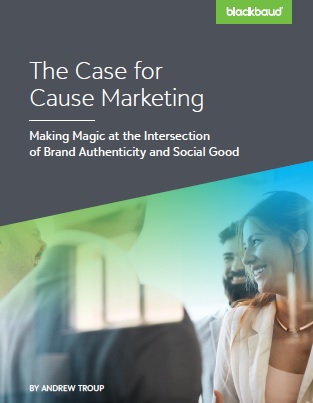The below is an excerpt from a new eBook from Blackbaud, The Case for Cause Marketing. Read the entire eBook here.
Who needs a seat at the table to build a successful cause marketing program?
As with other programs that fall under the strategic CSR umbrella, one question we often hear from social good champions at companies in the early stages of cause marketing programs is, “Who should own it?” While the ultimate owner—from a program accountability and budget perspective—of a company’s cause marketing initiative usually sits in the marketing department, we believe you need a variety of minds in the room to set the cause marketing strategy and reinforce cross-team alignment.
Who should be part of a company’s cause marketing task force? Look for:
- Your most strategic brand champion
This person may be cause marketing’s ultimate owner and will likely sit in the marketing or communications department. Cause marketing activities may be paid for from this person’s budget. This is someone who knows your brand promise by heart and has probably helped craft it with authenticity from the inside. This is someone who understands who your company is and what you stand for, and who has a point of view about what types of initiatives make sense for your company and what doesn’t feel aligned with the brand.
- Your most engaging storyteller
This person may be cause marketing’s ultimate owner and will likely sit in the marketing, communications or PR department. Cause marketing activities may be paid for from this person’s budget. This is someone who can take a marketing message and turn it into something that resonates with your audiences. This is someone who knows how to design a story that gets people thinking, clicking, and acting.
- Your preeminent customer whisperer
This person may be cause marketing’s ultimate owner and will likely sit in the marketing, sales enablement, or business development department. Cause marketing activities may be paid for from this person’s budget. This is someone who knows what makes your customers tick and what may tick them off. This is someone who has a pulse on customer data and always seems to have a creative idea to get new customers engaging with your company.
- Your business roadmap cartographer
This person is likely someone who should have input into cause marketing strategy but is not the ultimate owner. This person is driving your company’s business or product strategy and may sit in the C-suite. This person is charting the path your company will take over time and knows how your business strategy, products and services may change—or not—over the coming months and years.
- Your leader of the CSR charge
This person may not be the ultimate owner of cause marketing but should be a valued source of insight and support. This person may sit in a dedicated CSR department, within the HR umbrella, in a sustainability office, or somewhere else. Cause marketing activities may borrow from this person’s budget. This is someone who has an overarching view of your company’s CSR activities and can help build in critical alignment to complementary programs.
Of course, once your program is getting up and running, you’ll want to build and nurture close relationships with your counterparts on the nonprofit side as well. It’s important to remember that the corporation and nonprofit should view themselves as equal partners in a cause marketing initiative. Each brings something to the partnership that the other needs. Imagine every cause marketing-related headline you’ve seen: the company and the nonprofit are mentioned side-by-side, with equal PR real estate and equal contribution to the overall story.
“The power of profit-and-purpose partnerships is too great to leave your choice of nonprofit partners to chance. As we look to the future of cause marketing, many companies are expecting nonprofits to be true, reciprocal partners—not just philanthropic beneficiaries. We’re not necessarily talking business value— which was so much a part of the cause marketing conversation a few years back. We’re now seeing that a return on investment, or a return on partnership, comes in many shapes and sizes. Companies should seek out those nonprofit organizations that can provide expertise, transparency, community, and business impact. Finding the right organizations that can help your company affect true social change is crucial to the health of your triple bottom line.”
Learn more about building a successful cause marketing program by downloading the full eBook: The Case for Cause Marketing.
from npENGAGE https://ift.tt/2uXGycJ

0 comments:
Post a Comment